We have already discussed what a flywheel is and its uses in the previous article. A flywheel used in machines serves as a reservoir that stores energy during the period when the supply of energy is more than the requirement and releases it during the period when the requirement of energy is more than the supply. In the case of steam engines, internal combustion engines, reciprocating compressors, and pumps, the energy is developed during one stroke and the engine is to run for the whole cycle on the energy produced during this one stroke. Let us discuss the Fluctuation of energy in these cycles.
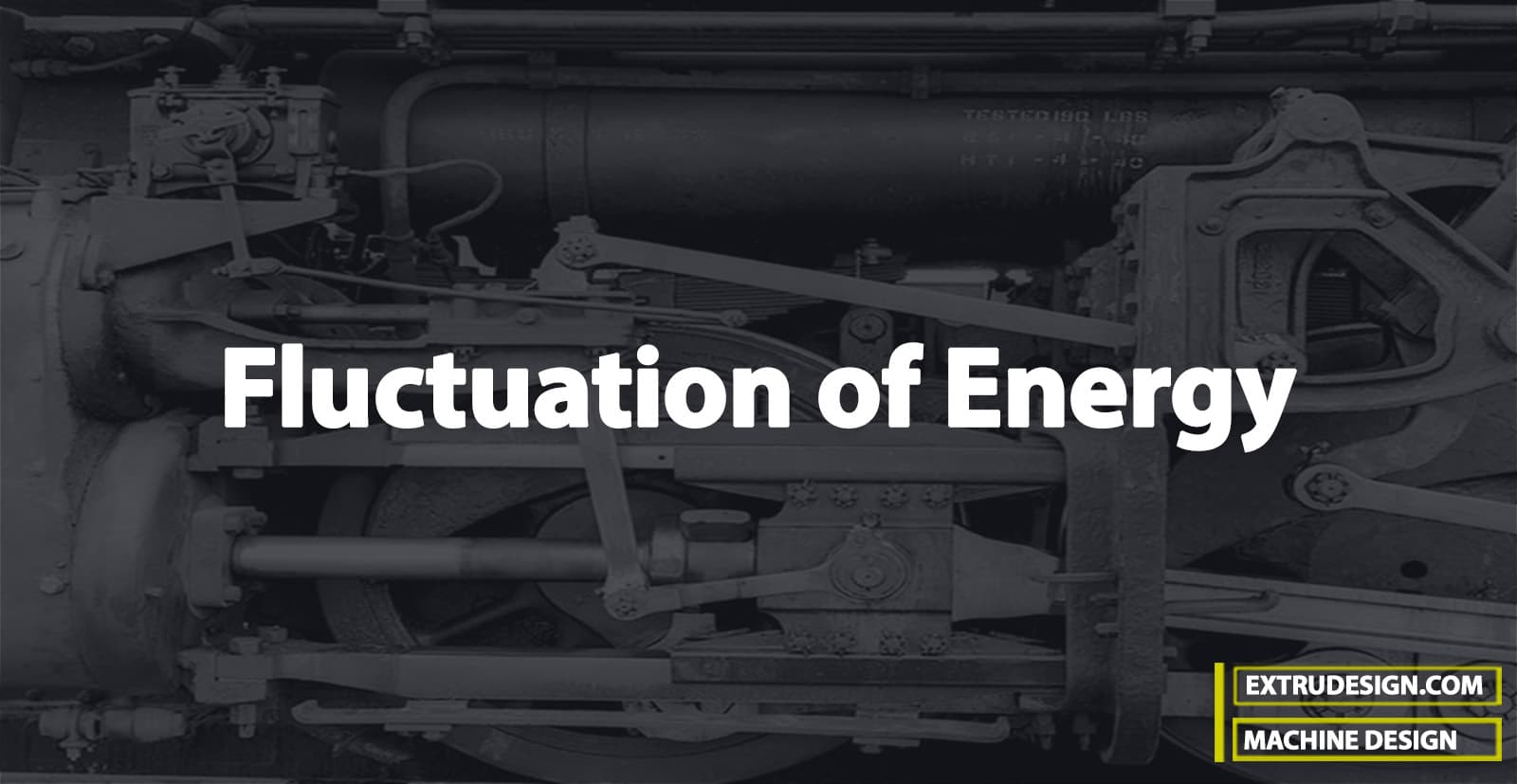
Fluctuation of Energy
The fluctuation of energy may be determined by the turning moment diagram for one complete cycle of operation. Consider a turning moment diagram for a single-cylinder double-acting steam engine as shown in the following figure. The vertical ordinate represents the turning moment and the horizontal ordinate (abscissa) represents the crank angle.
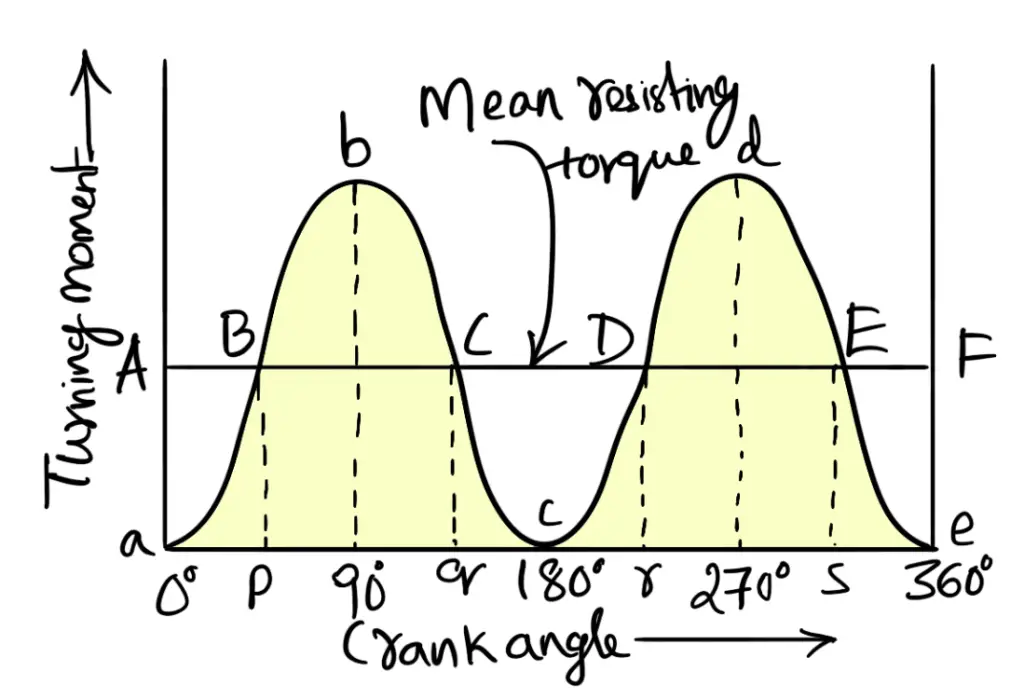
A little consideration will show that the turning moment is zero when the crank angle is zero. It rises to a maximum value when the crank angle reaches 90o and it is again zero when the crank angle is 180o. This is shown by the curve abc in the figure shown above. and it represents the turning moment diagram for outstroke. The curve cde is the turning moment diagram for instroke and is somewhat similar to the curve abc.
Since the work done is the product of the turning moment and the angle turned, therefore the area of the turning moment diagram represents the work done per revolution. In actual practice, the engine is assumed to work against the mean resisting torque, as shown by a horizontal line AF.
The height of the ordinate aA represents the mean height of the turning moment diagram. Since it is assumed that the work done by the turning moment per revolution is equal to the work done against the mean resisting torque, therefore the area of the rectangle aA Fe is proportional to the work done against the mean resisting torque.
We see in the above figure, that the mean resisting torque line AF cuts the turning moment diagram at points B, C, D and E. When the crank moves from ‘a’ to ‘p’ the work done by the engine is equal to the area aBp, whereas the energy required is represented by the area aABp. In other words, the engine has done less work (equal to the area aAB) than the requirement.
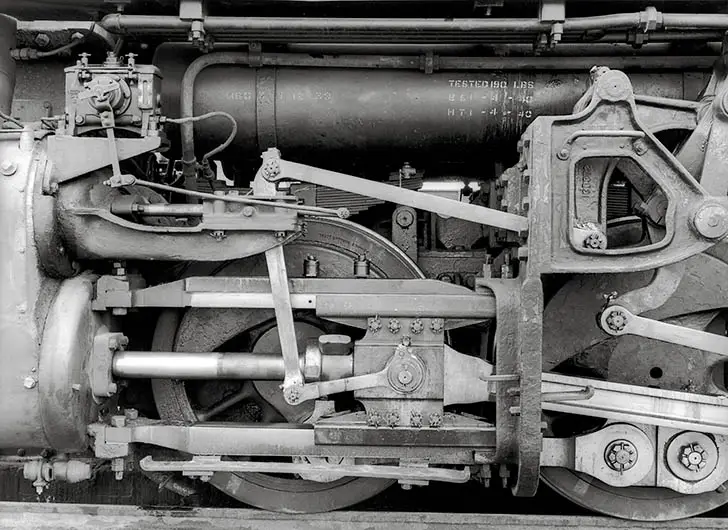
This amount of energy is taken from the flywheel and hence the speed of the flywheel decreases. Now the crank moves from p to q, the work done by the engine is equal to the area pBbCq, whereas the requirement of energy is represented by the area pBCq. Therefore the engine has done more work than the requirement. This excess work (equal to the area BbC) is stored in the flywheel and hence the speed of the flywheel increases while the crank moves from p to q.
Similarly, when the crank moves from q to r, more work is taken from the engine than is developed. This loss of work is represented by the area CcD. To supply this loss, the flywheel gives up some of its energy and thus the speed decreases while the crank moves from q to r. As the crank moves from r to s, excess energy is again developed given by the area DdE and the speed again increases. As the piston moves from s to e, again there is a loss of work and the speed decreases. The variations of energy above and below the mean resisting torque line are called fluctuation of energy. The areas BbC, CcD, DdE etc. represent fluctuations of energy.
A little consideration will show that the engine has a maximum speed either at q or at s. This is due to the fact that the flywheel absorbs energy while the crank moves from p to q and from r to s. On the other hand, the engine has a minimum speed either at p or at r. The reason is that the flywheel gives out some of its energy when the crank moves from a to p and from q to r. The difference between the maximum and the minimum energies is known as the maximum fluctuation of energy.
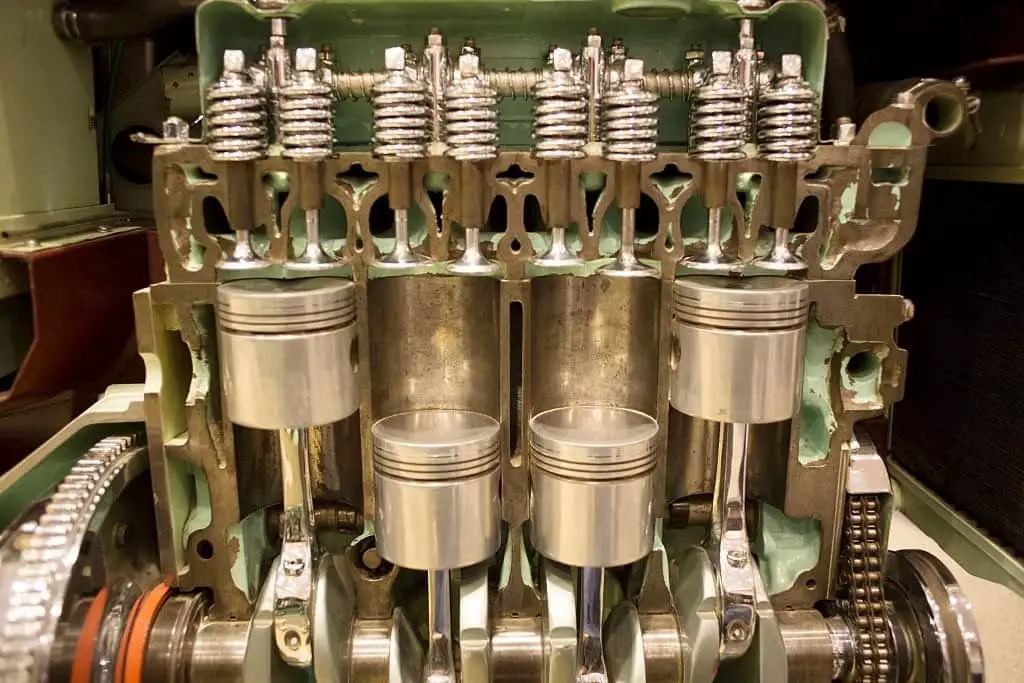
A turning moment diagram for a four-stroke internal combustion engine is shown in the following figure. We know that in a four-stroke internal combustion engine, there is one working stroke after the crank has turned through 720o (or 4π radians). Since the pressure inside the engine cylinder is less than the atmospheric pressure during the suction stroke, therefore a negative loop is formed as shown in the following figure.
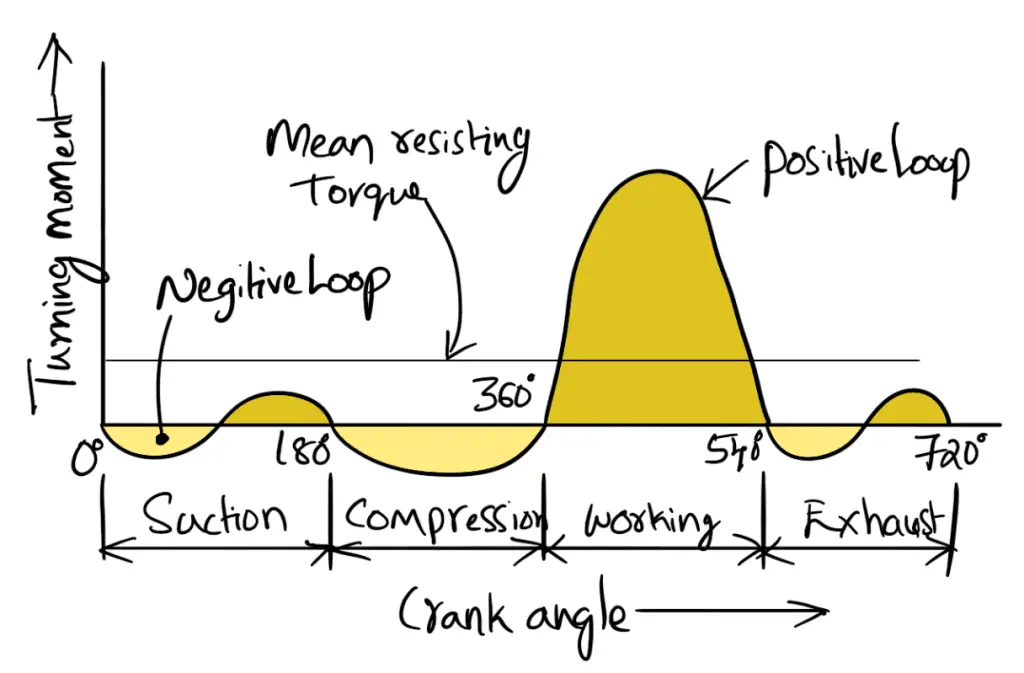
During the compression stroke, the work is done on the gases, therefore a higher negative loop is obtained. In the working stroke, the fuel burns, and the gases expand, therefore a large positive loop is formed. During the exhaust stroke, the work is done on the gases, therefore a negative loop is obtained.
A turning moment diagram for a compound steam engine having three cylinders and the resultant turning moment diagram is shown in the following figure.
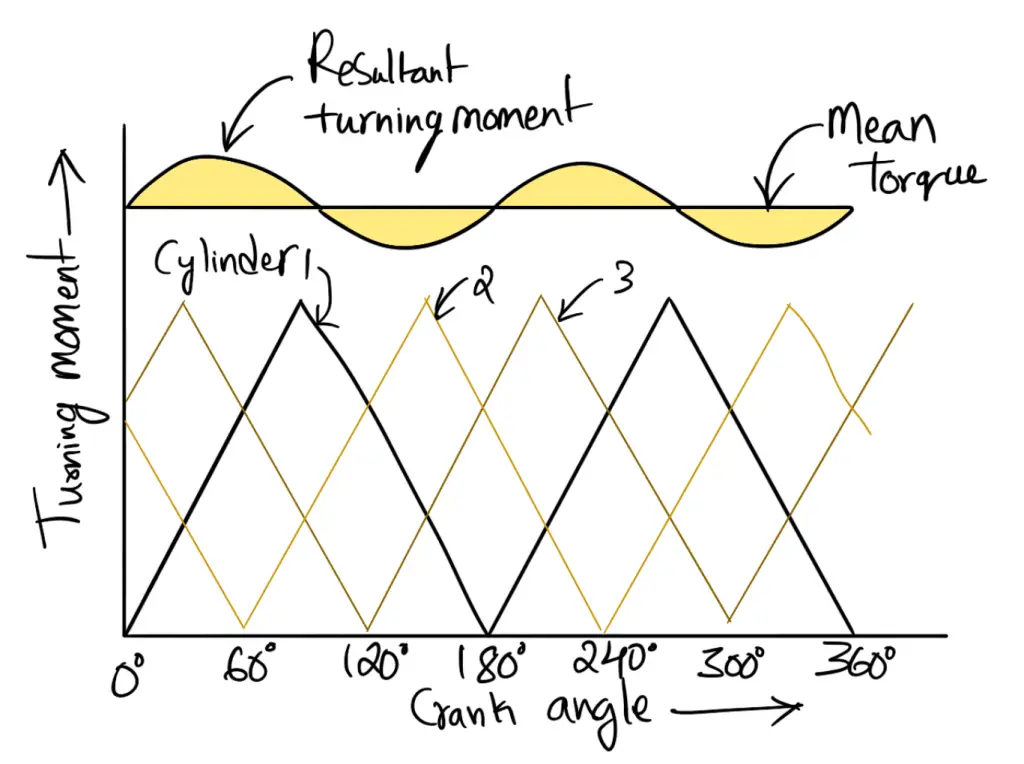
The resultant turning moment diagram is the sum of the turning moment diagrams for the three cylinders. It may be noted that the first cylinder is the high-pressure cylinder, the second cylinder is the intermediate cylinder and the third cylinder is the low-pressure cylinder. The cranks, in the case of three cylinders, are usually placed at 120o to each other.
Maximum Fluctuation of Energy
A turning moment diagram for a multi-cylinder engine is shown by a wavy curve in the following figure. The horizontal line AG represents the mean torque line.
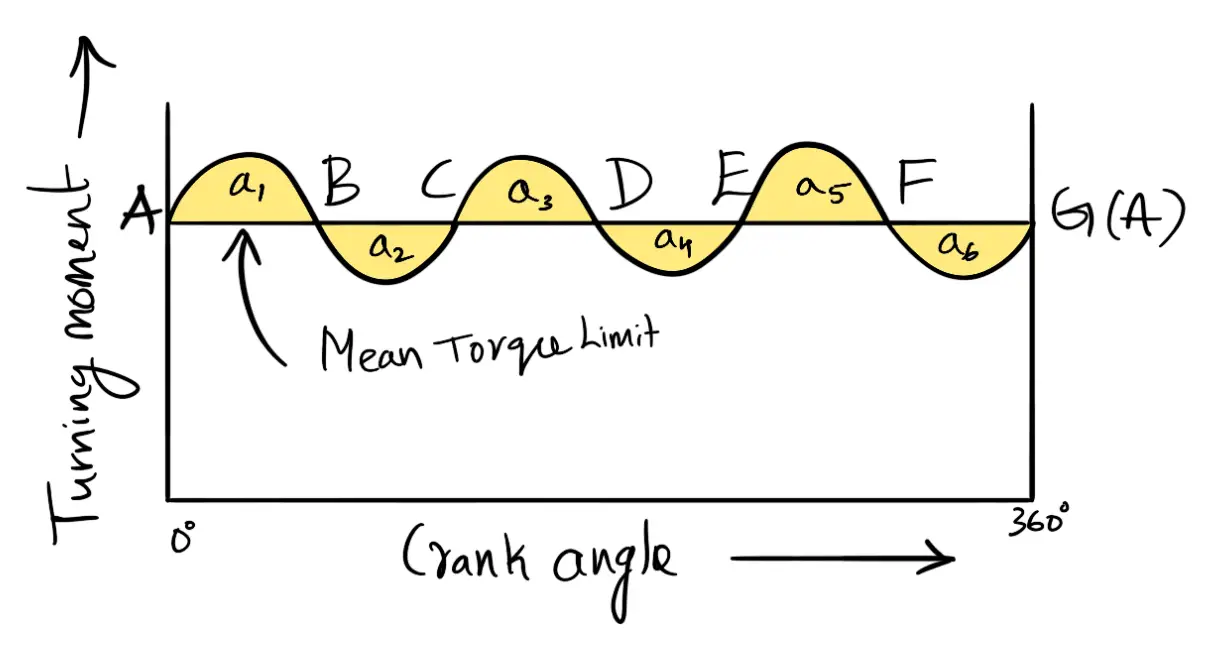
Let a1, a3, and a5 be the areas above the mean torque line and a2, a4, and a6 be the areas below the mean torque line. These areas represent some quantity of energy that is either added or subtracted from the energy of the moving parts of the engine.
Let the energy in the flywheel at A = E, then from the above figure, we have
Energy at B = E + a1
Energy at C = E + a1 – a2
Energy at D = E + a1 – a2 + a3
Energy at E = E + a1 – a2 + a3 – a4
Energy at F = E + a1 – a2 + a3 – a4 + a5
Energy at G = E + a1 – a2 + a3 – a4 + a5 – a6 = Energy at A
Maximum energy in the flywheel = E + a1
and minimum energy in the flywheel = E + a1 –a2 + a3 – a4
Maximum fluctuation of energy ∆Е = Maximum energy – Minimum energy
∆Е = (E + a1) – (E + a1 –a2 + a3 – a4)
∆Е = a2 – a3 + a4
Coefficient of Fluctuation of Energy
It is defined as the ratio of the maximum fluctuation of energy to the work done per cycle. It is usually denoted by CE. Mathematically, the coefficient of fluctuation of energy,

The work done per cycle may be obtained by using the following relation:
1. Work done/cycle = Tmean × θ
Where
Tmean = Mean torque
θ = Angle turned in radians per revolution
θ = 2 π, in the case of steam engines and two-stroke internal combustion engines.
θ = 4 π, in the case of four-stroke internal combustion engines
The following table shows the values of the coefficient of fluctuation of energy for steam engines and internal combustion engines.
| S.No. | Type of engine | Coefficient of fluctuation of energy (CE) |
| 1. 2. 3. 4. 5. | Single-cylinder, double-acting steam engine Cross-compound steam engine Single-cylinder, single-acting, four-stroke gas engine Four-cylinder, single-acting, four-stroke gas engine Six-cylinder, single-acting, four-stroke gas engine | 0.21 0.096 1.93 0.066 0.031 |
Let us know what you think about this article in the comment section below.

Leave a Reply